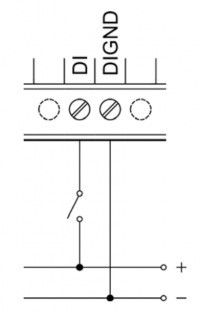This is an old revision of the document!
Digital inputy
Digitální vstupy slouží pro indikaci logického stavu TRUE/FALSE. Lze je použít také v režimu čítače, pro odečet z pulzních měřičů, sledování otáček motorů atd. Další možností je využití funkce DirectSwitch a navázat tak vstup na výstup.
Logický stav TRUE (sepnuto) je na vstupu signalizován rozsvícením LED diody s odpovídajícím označením, shodným s označením vstupu.
Software detekuje stav TRUE, pokud je vstupní napětí mezi daným DIx a DIGND v rozsahu 7-35 V⎓. Jestliže napětí klesne pod 3 V⎓, je stav vyhodnocen jako FALSE. Napětí v rozsahu 3-7 V⎓ je nedefinovaný stav.
Zapojení
Každý konektor s digitálními vstupy disponuje společnou svorkou DIGND, na kterou se připojuje záporný pól zdroje stejnosměrného napětí. Kladný pól zdroje se připojuje přes připojené externí zařízení na svorku DIx, případně DIy.x. Ilustrace na následujícím obrázku.
Poznámka:
Pro připojení externích zařízení na digitální vstupy doporučujeme použit jiný (oddělený) zdroj, než je použit k napájení zařízení (jednotka/Extension), aby bylo zajištěno galvanické oddělení. U každé skupiny digitálních výstupů naleznete i svorku DIGND určenou právě pro připojení záporného pólu samostatného zdroje.
Special functionality
Aside from the standard inputs and outputs, Patron units also feature additional functions for broadening the possible applications, performance optimization and monitoring of the entire project. These functions are calculated directly by the I/O section's microprocessors, making them independent on the control software.
Counter input
One of the most interesting functions is counter input - a high-speed rising edge counter independent on the control software. Simply put, the counter can very accurately detect even very short pulses.
Counter inputs are suitable especially for collecting data from energy meters, water meters, gas meters and other pulse meters installed in HVAC systems. They are also useful for reading engine revolutions. For this purpose, Unipi units feature 64-bit registers. When the maximum value of the counter (4 294 967 295) is exceeded, the counter resets to 0. Counter inputs can be used at up to 10 kHz frequency; in the Mervis IDE library devices, they are labelled as CNT inputs.
Direct Switch
The DirectSwitch function can be used on any unit or extension module equipped with digital inputs and digital or relay outputs within a single section.
This function allows logical connection of digital input to digital output or relay output to automatically perform one of the available operation. DirectSwitch is independent on the control software running on unit and is suitable for control of lighting or any other time-critical applications (typically, the output response time matches the input response).
The function can be configured for one of three modes:
- Copy - input state is copied to the output
- Inverse copy - negated state of the input is set on the output
- Switch - if a rising edge is detected on the input, the output state is negated
- (Block - disables DirectSwitch)
Note:
DirectSwitch function can be configured only for the corresponding input and output, ie. only for DI_y.x input and DO_y.x (ROy.x) output, where x and y (if the y is given) numbers must match. It is not possible to use DirectSwitch simultaneously for input and output with mismatched labels, eg. DI_x.y and DO_v.z. It is also not possible to use the function for a single input and multiple outputs at the same time.
If DirectSwitch is applied to an output, it is not possible to write onto output (DO) in a regular way. Instead, you need to set the ForceOutput register to TRUE for approx. 1 second.
Technical parameters
| Input type | SINK |
| Input terminal | DI |
| Common ground | DIGND |
| Maximum voltage for FALSE | 3 V DC |
| Minimum voltage for TRUE | 7 V DC |
| Maximum voltage | 35 V DC |
| Non-defined state | 3-7 V DC |
| Input resistance for TRUE | 6 200 Ω |
| Voltage drop on DI diode | 1.2 V |
| Minimum pulse length | 20 μs |
| FALSE –> TRUE delay | 20 μs |
| TRUE –> FALSE delay | 60 μs |
| Maximum CNT counter input frequency | 10 kHz |
| Galvanic isolation | Yes (between the groups*) |
| Insulation voltage | 2 000 V |
